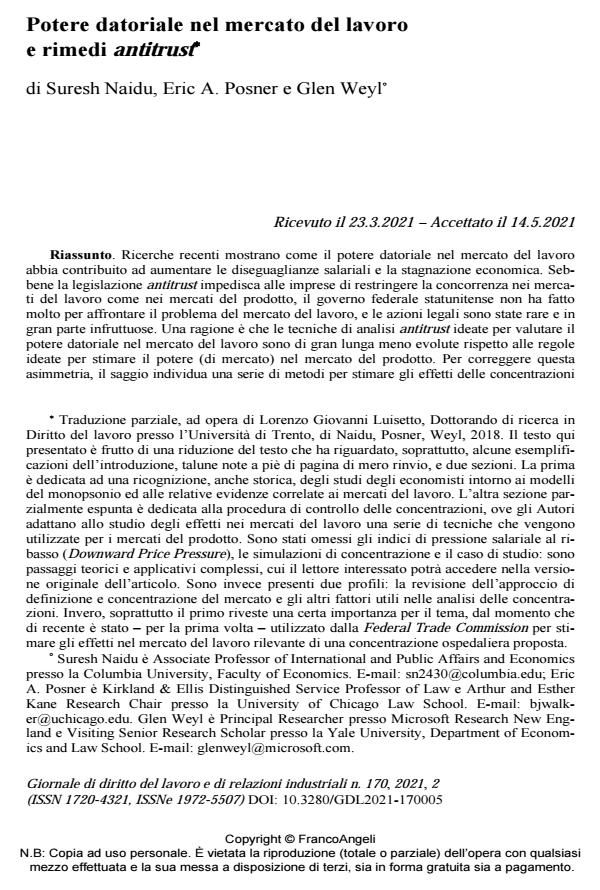Potere datoriale nel mercato del lavoro e rimedi antitrust
Titolo Rivista GIORNALE DI DIRITTO DEL LAVORO E DI RELAZIONI INDUSTRIALI
Autori/Curatori Suresh Naidu, Eric A. Posner , Glen Weyl
Anno di pubblicazione 2021 Fascicolo 2021/170
Lingua Italiano Numero pagine 32 P. 257-288 Dimensione file 339 KB
DOI 10.3280/GDL2021-170005
Il DOI è il codice a barre della proprietà intellettuale: per saperne di più
clicca qui
Qui sotto puoi vedere in anteprima la prima pagina di questo articolo.
Se questo articolo ti interessa, lo puoi acquistare (e scaricare in formato pdf) seguendo le facili indicazioni per acquistare il download credit. Acquista Download Credits per scaricare questo Articolo in formato PDF

FrancoAngeli è membro della Publishers International Linking Association, Inc (PILA)associazione indipendente e non profit per facilitare (attraverso i servizi tecnologici implementati da CrossRef.org) l’accesso degli studiosi ai contenuti digitali nelle pubblicazioni professionali e scientifiche
Ricerche recenti mostrano come il potere datoriale nel mercato del lavoro abbia contribuito ad aumentare le diseguaglianze salariali e la stagnazione economica. Sebbene la legislazione anti-trust impedisca alle imprese di restringere la concorrenza nei mercati del lavoro come nei mer-cati del prodotto, il governo federale statunitense non ha fatto molto per affrontare il problema del mercato del lavoro, e le azioni legali sono state rare e in gran parte infruttuose. Una ragione è che le tecniche di analisi antitrust ideate per valutare il potere datoriale nel mercato del lavoro sono di gran lunga meno evolute rispetto alle regole ideate per stimare il potere (di mercato) nel mercato del prodotto. Per correggere questa asimmetria, il saggio individua una serie di metodi per stimare gli effetti delle concentrazioni nei mercati del lavoro. Gli Autori estendono poi que-sto approccio ad altre condotte anticoncorrenziali realizzate dai datori di lavoro nei confronti dei lavoratori. Da ultimo, il saggio evidenzia alcuni argomenti e prove che indicano come il potere di mercato possa essere addirittura più significativo nei mercati del lavoro che nei mer-cati del prodotto.
Parole chiave:Potere datoriale; Mercati del lavoro; Monopsonio; Antitrust; Class action; Con-centrazione; Patto di non concorrenza
Suresh Naidu, Eric A. Posner , Glen Weyl, Potere datoriale nel mercato del lavoro e rimedi antitrust in "GIORNALE DI DIRITTO DEL LAVORO E DI RELAZIONI INDUSTRIALI " 170/2021, pp 257-288, DOI: 10.3280/GDL2021-170005